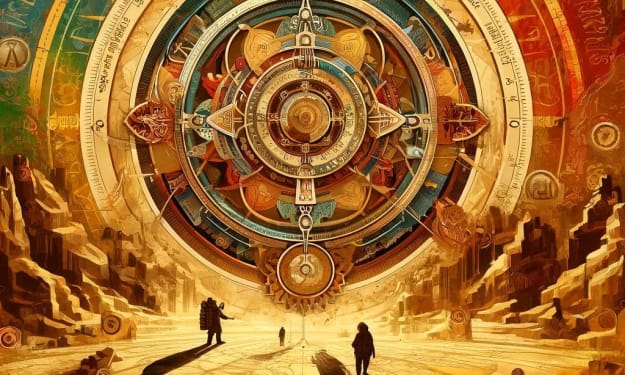Unveiling the Tapestry of History
A Journey through Time on the World History Chart

In this article, I will provide a comprehensive overview of human history using my latest timeline of world history chart available as a poster on my website, usefulcharts.com. I will discuss how history can be divided into distinct time periods or ages, emphasizing significant turning points in world history.
Firstly, let's understand how the chart functions. The vertical scale represents the passage of time, with time progressing downwards on the page. Each white line represents a century, and the scale is equidistant, maintaining the same distance between lines from top to bottom. This ensures accurate comparisons and provides viewers with a proper sense of time. Horizontally, different sections of the chart represent various regions of the world. Starting from the far left, we have the Americas, followed by Africa, Europe, Asia, and finally, the Pacific Islands. Each line on the chart signifies a specific culture, civilization, or empire, with the width of the line indicating its relative importance compared to others from the same period or region.
Before delving further, it's crucial to clarify the terms "AD" and "BC" and their equivalents "CE" and "BCE." "AD" stands for "anno Domini," Latin for "in the year of the Lord." It measures years from the birth of Jesus. Anything prior to Jesus' birth is referred to as "BC," meaning "before Christ." Scholars generally agree that Jesus was likely born in 4 BC, which should be noted as a slight discrepancy in the scale. Moving backward in time, the AD dates decrease, and once we reach BC, the dates start increasing again. It's important to note that there is no Year Zero, so the year 1 BC is immediately followed by 1 AD. In recent times, historians increasingly employ the terms "CE" (Common Era) and "BCE" (before the Common Era) as more neutral alternatives since Christianity does not represent the majority of the world's population.
Now, let's address the starting point of history, the line between history and prehistory. On this chart, the year 3300 BCE is chosen as the starting point because it roughly aligns with the emergence of writing systems. The concept is that history relies on written records, and thus, everything before the advent of writing is categorized as prehistory. It is essential to recognize that prehistory extends much further back, encompassing the prehistoric era of Homo sapiens, dating back around 200,000 years, commonly referred to as the Stone Age. If we consider the prehistory of planet Earth, it spans approximately 4.5 billion years. However, this chart focuses on written records and begins with the emergence of writing systems.
The chart divides history into six main periods: the Early Bronze Age, the Bronze Age, the Iron Age, Classical Antiquity, the Middle Ages, and the Modern Period. Let's explore each period in more detail.
The Bronze Age derives its name from the use of bronze, which coincided with the development of writing. This period witnessed significant advancements in three main regions: Egypt, Sumer (modern-day Iraq), and the Indus Valley (modern-day Pakistan). Unfortunately, the writing system used in the Indus Valley remains undeciphered, but we have access to records from Egypt and Sumer. These civilizations engaged in trade and experienced growth in size and technology during the Early Bronze Age. The Sumerians had already invented the wheel, plow, and sail, and they further developed astronomy and mathematics. In Egypt, the construction of the Great Pyramids of Giza took place during this era. Another noteworthy civilization during the Early Bronze Age was the Norte Chico civilization in what is now Peru, although they lacked.
The study of history serves as a crucial foundation for understanding our collective past, shaping our present, and guiding our future. The World History Chart, a comprehensive visual representation of historical events and timelines, plays a vital role in unraveling the tapestry of history and contributing to humanity's knowledge and understanding. In this article, we delve into how the World History Chart contributes to the enrichment of human civilization, fostering cultural appreciation, promoting interdisciplinary connections, and inspiring new perspectives.
Fostering Cultural Appreciation: The World History Chart serves as a gateway to diverse cultures, civilizations, and historical periods. By presenting a visual panorama of human history, it facilitates the exploration and appreciation of different societies, their customs, beliefs, achievements, and struggles. As individuals engage with the Chart, they gain a deeper understanding of the richness and diversity of human experiences throughout time, fostering cultural empathy and promoting a sense of global interconnectedness.
Connecting Disciplines and Fields: History is an interdisciplinary field that intersects with various disciplines, such as anthropology, sociology, political science, economics, and more. The World History Chart acts as a unifying tool, connecting these disciplines by showcasing the interplay of historical events with social, political, economic, and cultural contexts. By highlighting these connections, the Chart encourages a holistic approach to knowledge, enabling individuals to grasp the complex interactions that have shaped human societies and civilizations.
Inspiring Critical Thinking: The World History Chart serves as a catalyst for critical thinking and analysis. As individuals navigate the Chart's intricate web of historical events, they are prompted to question, evaluate evidence, and engage in historical reasoning. This process fosters analytical skills, encourages the examination of multiple perspectives, and enables individuals to develop a nuanced understanding of historical narratives. By inspiring critical thinking, the Chart empowers individuals to navigate the complexities of the past and make informed judgments about the present.
Encouraging Historical Inquiry: The World History Chart acts as a springboard for further historical inquiry and research. It provides a comprehensive overview that helps individuals identify gaps in their knowledge and sparks curiosity about specific periods, events, or civilizations. By inspiring individuals to delve deeper into particular areas of interest, the Chart stimulates intellectual curiosity and motivates lifelong learning. This pursuit of knowledge contributes to the expansion of historical scholarship and the continuous refinement of our understanding of the past.
Nurturing Collective Memory: The World History Chart plays a pivotal role in preserving and nurturing collective memory. By visualizing the continuum of human history, it helps societies reflect on their shared heritage, collective achievements, and collective challenges. The Chart aids in the transmission of historical knowledge across generations, ensuring that important lessons from the past are not forgotten. By nurturing collective memory, the Chart strengthens social cohesion, fosters a sense of identity, and guides societies toward a future grounded in historical wisdom.
Conclusion: The World History Chart, as a comprehensive visual representation of historical events and timelines, significantly contributes to humanity's knowledge and understanding. By fostering cultural appreciation, connecting disciplines, inspiring critical thinking, encouraging historical inquiry, and nurturing collective memory, the Chart enriches human civilization. It serves as a valuable tool for educators, students, researchers, and anyone interested in unraveling the tapestry of history, guiding us on a journey through time and offering profound insights into the collective human experience. Through its enduring contributions, the World History Chart continues to shape our understanding of the past, enlighten the present, and inspire future generations to create a more informed and compassionate world.
About the Creator
Emmanuel Osuolale
I'm a versatile professional, specializing in writing. As a writer, I have honed my craft over the years, by providing engaging and informative content across various genres and industries.
Enjoyed the story? Support the Creator.
Subscribe for free to receive all their stories in your feed. You could also pledge your support or give them a one-off tip, letting them know you appreciate their work.





Comments (1)
Wow.... This is a great write-up. Keep it up Bro